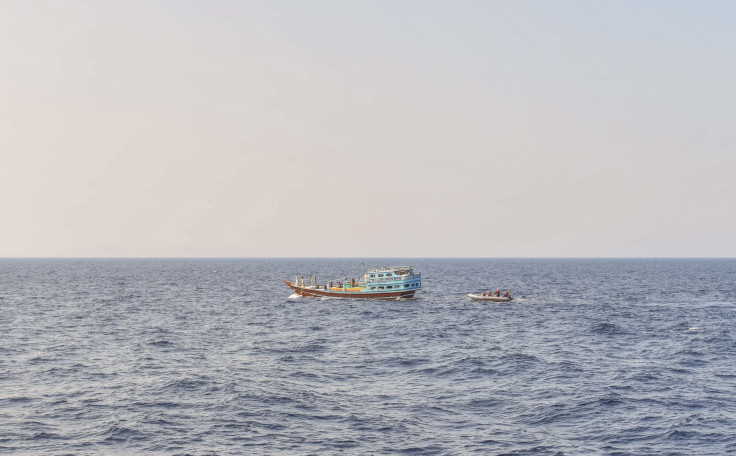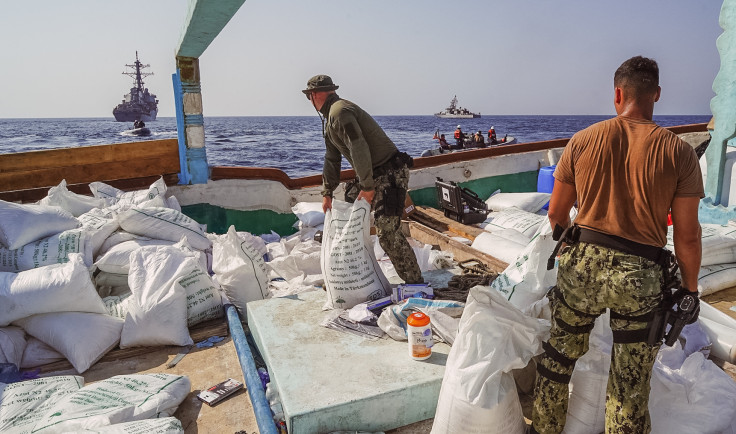US Navy Intercepts Vessel Carrying 'Massive Amount' Of Explosive Material Headed From Iran To Yemen
KEY POINTS
- The U.S. forces sunk the vessel as it was considered a hazard to navigation for commercial shipping
- Yemen's Iran-backed Houthi rebels are fighting the country's government
- Under the U.N. Security Council resolution, supply of weapons to the Houthis is prohibited
The U.S. Navy reportedly intercepted a fishing vessel carrying a "large quantity" of explosive material in the Gulf of Oman heading from Iran toward Yemen.
Following search and investigation, the vessel was scuttled. A statement issued Tuesday by the US Naval Forces Central Command said: "On November 8, US 5th Fleet intercepted a fishing vessel in the Gulf of Oman smuggling lethal aid, including a large quantity of explosive material, from Iran to Yemen."
The vessel and its four Yemeni crew members were intercepted as they transited from Iran "along a route historically used to traffic weapons to the Houthis in Yemen."

During the search, the U.S. forces discovered the vessel was carrying more than 70 tons of ammonium perchlorate, "a powerful oxidizer commonly used to make rocket and missile fuel as well as explosives," the statement added. This is the 5th Fleet's first ever interdiction of ammonium perchlorate.
"This was a massive amount of explosive material, enough to fuel more than a dozen medium-range ballistic missiles depending on the size," Vice Adm. Brad Cooper, commander of the U.S. Naval Forces Central Command, U.S. 5th Fleet and Combined Maritime Forces, said, according to the statement.
The vessel was also found to be carrying more than 100 tons of urea fertilizer, known for its use as an explosive precursor.
"The unlawful transfer of lethal aid from Iran does not go unnoticed. It is irresponsible, dangerous and leads to violence and instability across the Middle East," Cooper added.
Following a weeklong search and verification of the material seized, the vessel was sunk after the U.S. forces determined it was a hazard to navigation for commercial shipping.
Since 2014, Iran-backed Houthi rebels in Yemen have been fighting against the internationally recognized government of the country, backed by a Saudi-led military coalition. The rebel group has also been carrying out attacks on targets in Saudi Arabia and the Red Sea.
Under the U.N. Security Council Resolution 2216 direct or indirect supply, sale or transfer of weapons to the Houthis is prohibited. But, several investigation reports, including one by the U.N., have found the rebels have been receiving weapons, including ballistic missiles from Iran.
The Wall Street Journal in January 2022 cited a draft U.N. report, which said thousands of weapons meant for the Houthi rebels, seized by the U.S. Navy in the Arabian Sea, had likely originated from Jask in Iran's southeast.
Meanwhile, Tehran claims it only supports the Houthi movement diplomatically, and denies providing the group with arms.
In the recent months, there has been a series of encounters between Iran and the U.S. in the region. Tehran has built up its naval presence particularly in support of the Houthi Movement, while the U.S. Navy has increased patrolling in the waters around the Middle East.

© Copyright IBTimes 2024. All rights reserved.






















